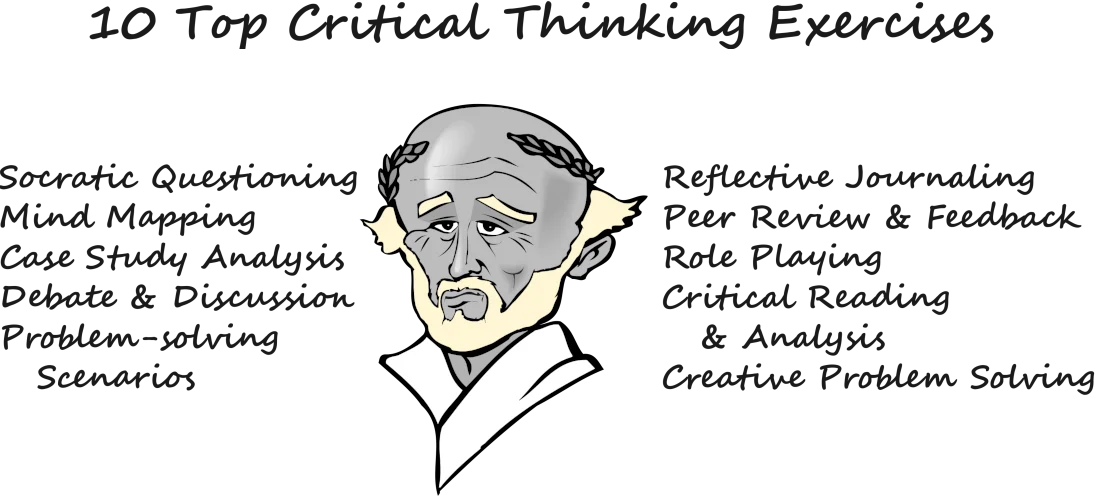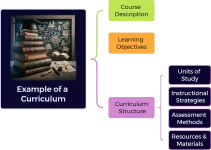
Critical thinking exercises help mold individuals to become incisive thinkers. Developing critical thinking skills takes time but the length it takes paves the way towards innovative solutions to the world’s problems.
This article discusses the top 10 approaches on how to harness critical thinking. These approaches are discussed in detail with examples on how to implement them whether in a classroom setting or in real-world situations.
Table of Contents
Introduction
Critical thinking is a fundamental skill that plays a crucial role in both academic and professional environments. In today’s age of AI, where information is abundant and decisions need to be made swiftly, honing your critical thinking abilities is more important than ever. As middle-aged adults, professionals often face complex challenges in their careers that require them to analyze situations, evaluate information, and make sound judgments.
By engaging in “critical thinking exercises,” individuals can sharpen their cognitive abilities, improve problem-solving skills, and enhance their decision-making processes. These exercises are designed to challenge individuals to think critically, question assumptions, and consider alternative perspectives. For professionals seeking to advance in their careers, mastering critical thinking is a valuable asset that can set them apart in a competitive job market.
Critical thinking exercises can sharpen individual’s cognitive abilities, improve problem-solving skills, and enhance decision-making.
Now, let’s explore the top 10 critical thinking exercises and gain an idea on how you can use it as educational professionals, both at undergraduate and graduate levels. You may combine the teaching strategies to make the learning environment more varied and exciting. After all, the acquisition of knowledge and skills, and even attitude need not be boring. Some of the exercises are also applicable to personal and professional development.
Top 10 Critical Thinking Exercises
I will discuss in the following sections the curated teaching strategies to develop critical thinking skills. Many of these have already been used in classroom settings although many teachers or education professionals tend to veer on the common ones like simple lectures, group discussion, essay writing, among others.
The challenge lies on the mentors or facilitators on how to teach critical thinking skills especially if the educational institution on which this occurs operates using a creative curriculum. Chances are, you have already used some of them, but was unable to make the most of the teaching approach. There is a tendency to dwell on what’s common.
Related post: Creative Curriculum: Concepts and Examples
These top 10 critical thinking exercises are designed to enhance analytical thinking, problem-solving abilities, and decision-making skills. Each exercise offers unique benefits that can be applied in both academic and professional contexts, empowering individuals to approach challenges with a strategic mindset and creativity.
Exercise 1: Socratic Questioning
Socratic Questioning involves probing deeper into issues by asking thought-provoking questions. This exercise encourages individuals to explore assumptions, analyze evidence, and consider alternative perspectives.
In academic settings, implementing Socratic seminars can foster engaging discussions and promote critical thinking among students. In professional environments, incorporating Socratic questioning techniques can lead to more insightful problem-solving and decision-making processes.
Here are examples of Socratic questioning at different levels.
College Students
Research Methods (Undergraduate Level)
Context: Preparing a basic research proposal
- “What is the main problem your study is trying to address?”
- “Why is this topic important to your field or society in general?”
- “What do you think might limit the accuracy of your data?”
- “Are your variables clearly defined and measurable?”
- “What would it mean if your hypothesis is not supported?”
Philosophy or Ethics (General Education or Humanities)
Context: Analyzing a moral dilemma or philosophical argument
- “What assumptions does this philosopher make about human nature?”
- “Can two conflicting viewpoints both be valid? Why or why not?”
- “Is there ever a situation where the ends justify the means?”
- “What ethical principles are at play in this scenario?”
- “How might someone from a different culture interpret this issue?”
Environmental Science or Sustainability (Introductory Course)
Context: Evaluating environmental issues or climate policy
- “What evidence supports your view on this issue?”
- “How do different communities experience this environmental problem?”
- “What are the trade-offs of your proposed solution?”
- “What role should governments play in solving this issue?”
- “If we do nothing, what are the likely consequences?”
Graduate Students
Advanced Research or Thesis Seminar
Context: Defending a research design or proposal
- “What theoretical or conceptual framework guides your study?”
- “How does your research contribute to existing knowledge?”
- “What are the epistemological assumptions behind your methodology?”
- “Where might bias enter into your data analysis?”
- “How might your findings be misinterpreted or misused?”
Public Policy, Education, or Social Sciences
Context: Critically evaluating a policy, program, or theoretical model
- “What ideological or theoretical lens does this policy reflect?”
- “Whose interests are served or ignored by this policy?”
- “What systemic factors contribute to the issue being addressed?”
- “What empirical evidence supports or challenges this intervention?”
- “If you were a policymaker, how would you balance competing priorities?”
Exercise 2: Mind Mapping
Mind Mapping is a visual tool that helps individuals organize thoughts, ideas, and information in a structured format. By creating visual representations of concepts, relationships, and data, mind mapping enhances cognitive clarity and promotes creative thinking.
In academic contexts, using mind maps can aid in studying complex topics and improving information retention. In professional settings, mind mapping can streamline project planning, brainstorming sessions, and strategic decision-making processes.
Related post: Mind Mapping: A Powerful Way to Attain What You Want
Exercise 3: Case Study Analysis
Case Study Analysis involves examining real-world scenarios to apply theoretical knowledge and analytical skills. By dissecting case studies, individuals can identify key issues, analyze data, and develop informed solutions.
In academic environments, analyzing case studies enhances critical thinking and problem-solving abilities across various disciplines. In professional development, case study analysis sharpens decision-making skills, fosters strategic thinking, and prepares individuals to tackle complex challenges in their careers.
Example: A Case Analysis on Nell’s Language Acquisition
Exercise 4: Debate and Discussion
Debate and Discussion exercises encourage individuals to articulate and defend their viewpoints while considering opposing perspectives. Engaging in debates promotes critical thinking, communication skills, and the ability to construct persuasive arguments.
In academic settings, organizing debates on relevant topics cultivates analytical thinking and encourages students to explore diverse viewpoints. In professional contexts, debates foster collaboration, creativity, and the exchange of ideas, leading to innovative solutions and informed decision-making.
Exercise 5: Problem-Solving Scenarios
Problem-Solving Scenarios involve presenting individuals with hypothetical situations that require creative solutions. By working collaboratively to solve complex problems, participants enhance their analytical thinking, teamwork, and decision-making skills.
In academic settings, problem-solving scenarios promote critical thinking and practical application of knowledge. In professional development, these exercises simulate real-world challenges, preparing individuals to identify and deal with uncertainties, think strategically, and innovate in their roles.
Examples
Science or Engineering (College Level)
Scenario: Students are given a case where a rural village lacks access to clean drinking water. They must design a cost-effective, sustainable filtration system using locally available materials.
Skills Developed:
- Applying scientific principles to real-world needs
- Evaluating trade-offs in cost, efficiency, and feasibility
- Working in teams to design, prototype, and present solutions
Psychology or Social Work (Graduate Level)
Scenario: A case study describes a teenager displaying symptoms of anxiety and depression after relocating due to a natural disaster. Students must develop an intervention plan considering cultural, psychological, and social factors.
Skills Developed:
- Critical application of theoretical frameworks
- Empathetic and holistic decision-making
- Collaborative assessment and planning
Public Administration or Environmental Policy (Graduate Level)
Scenario: Students role-play as members of a local government council deciding how to allocate a limited disaster recovery budget among competing needs: housing, infrastructure, healthcare, and education.
- Skills Developed:
- Prioritization under resource constraints
- Stakeholder analysis
- Realistic negotiation and policy-making
Business Strategy or Management Training
Scenario: A company is losing market share to a disruptive competitor. Teams must analyze sales data, customer feedback, and competitor strategies to propose a turnaround plan.
Skills Developed:
- Strategic thinking
- Cross-functional collaboration
- Data-driven decision-making
Tech Industry or Project Management Training
Scenario: A development team is behind schedule on a software launch. Participants must identify bottlenecks, reassign resources, and communicate with stakeholders to realign the timeline and minimize losses.
Skills Developed:
- Agile thinking and project prioritization
- Effective communication under constraints
- Problem resolution and adaptive planning
Exercise 6: Reflective Journaling
Reflective Journaling encourages individuals to introspect, analyze experiences, and extract valuable insights. By documenting thoughts, emotions, and learning processes, reflective journaling enhances self-awareness, critical reflection, and personal growth.
In academic contexts, regular journaling promotes metacognitive skills and deepens understanding of course materials. In professional settings, reflective journaling fosters continuous learning, self-improvement, and the development of adaptive strategies to overcome challenges in the workplace.
Example of a reflective journal
Reflective Journal Entry
Date: July 22, 2025
Activity: Group Problem-Solving – Designing a Research Study
Reflection:
Today, our group was tasked with designing a research study to investigate the effects of online learning on student motivation. At first, we struggled to agree on a clear hypothesis, but through discussion, we realized we had different assumptions about what “motivation” means. This made me reflect on how important it is to define variables clearly in research.
Working with others helped me see new perspectives I hadn’t considered, especially when a teammate suggested we include both quantitative and qualitative methods. I’ve learned that listening actively and being open to revision are essential in collaborative work. This activity improved my critical thinking and reminded me that good research is not just about methods—it’s also about asking the right questions.
Exercise 7: Peer Review and Feedback
Peer Review and Feedback involve critiquing and providing constructive feedback on peers’ work. This exercise promotes critical analysis, communication skills, and collaboration.
In academic environments, peer review sessions enhance students’ ability to evaluate and improve their work based on diverse perspectives. In professional development, peer review fosters a culture of continuous improvement, constructive criticism, and knowledge sharing, leading to enhanced performance, innovation, and quality outcomes. It avoids the pitfalls of having a personal bias.
Related post: 10 Benefits of Peer Review in Research Writing
Exercise 8: Role-Playing
Role-Playing exercises involve simulating real-life scenarios to explore different perspectives and practice decision-making skills. By assuming different roles and engaging in interactive scenarios, participants develop empathy, communication skills, and creative problem-solving abilities.
In academic settings, role-playing exercises enhance students’ understanding of complex concepts and promote experiential learning. In professional contexts, role-playing fosters empathy, teamwork, and conflict resolution skills, preparing individuals to navigate interpersonal dynamics and complex situations in the workplace.
Related post demonstrating role playing: How to Apply Suggestopedia as a Method of Teaching
Exercise 9: Critical Reading and Analysis
Critical Reading and Analysis tasks involve evaluating texts, articles, or research papers with a discerning eye. By analyzing content, identifying key arguments, and evaluating evidence, individuals enhance their critical thinking, research skills, and information literacy.
In academic settings, assigning critical reading tasks with guided analysis questions promotes deep comprehension, analytical thinking, and evidence-based reasoning. In professional development, critical reading exercises sharpen individuals’ ability to extract valuable insights, make informed decisions, and stay abreast of industry trends and developments.
Related post: Writing a Critique Paper: Seven Easy Steps
Exercise 10: Creative Problem Solving
Creative Problem Solving exercises encourage individuals to think outside the box, generate innovative ideas, and explore unconventional solutions. By engaging in brainstorming sessions, individuals enhance their creativity, lateral thinking, and adaptability.
In academic environments, creative problem-solving exercises foster originality, experimentation, and the development of unique solutions to complex problems. In professional settings, these exercises stimulate innovation, encourage risk-taking, and empower individuals to approach challenges with a fresh perspective, driving creativity and strategic decision-making in the workplace.
Conclusion
As professionals in the AI-driven workplace, the integration of critical thinking exercises is paramount for career growth and organizational success. By actively engaging in exercises like Reflective Journaling and Peer Review, individuals can cultivate essential skills such as effective communication and empathy, crucial for leadership roles and team dynamics. These exercises not only enhance personal capabilities but also foster a culture of continuous learning and innovation within the workplace.
Furthermore, critical thinking exercises play a pivotal role in improving workplace efficiency. By encouraging employees to critically analyze information and generate creative solutions, organizations can streamline decision-making processes and adapt swiftly to changing business landscapes. Activities like Critical Reading and Creative Problem Solving empower professionals to approach challenges strategically, leading to more efficient outcomes and a competitive edge in the industry.
Incorporating critical thinking exercises into professional development programs is not just beneficial for individuals but also for the overall organizational environment. These exercises promote a culture of collaboration, innovation, and adaptability, essential for thriving in today’s dynamic business world. By embracing critical thinking as a core competency, professionals can navigate complexities with confidence, make informed decisions, and drive success in their respective fields.



